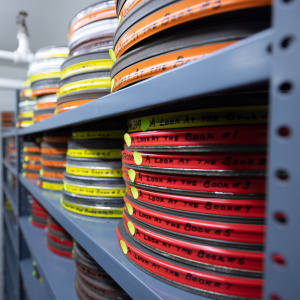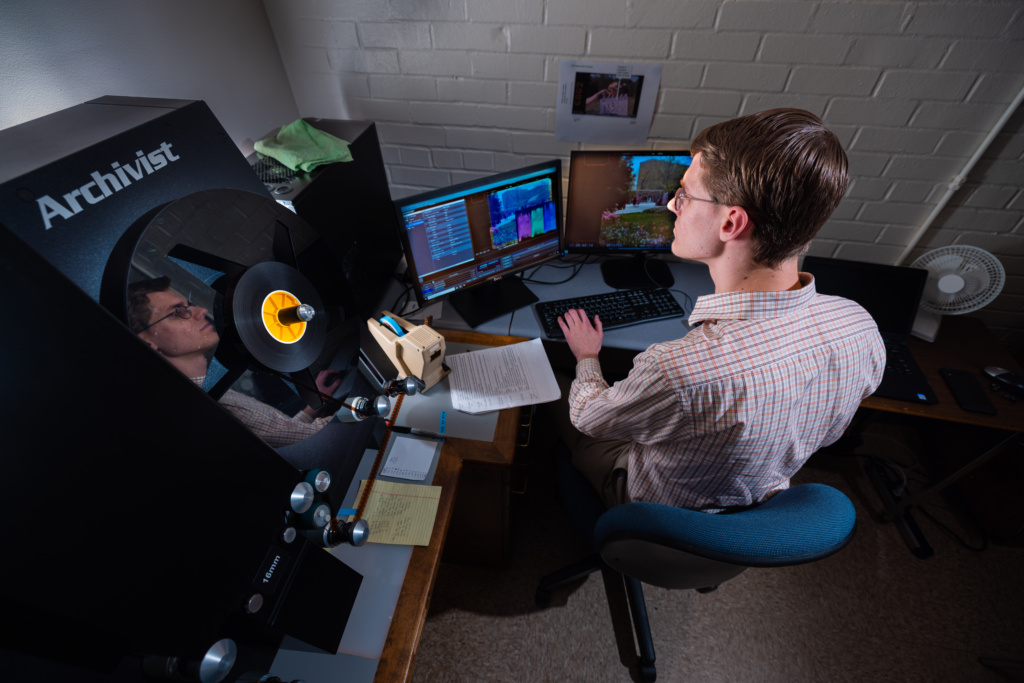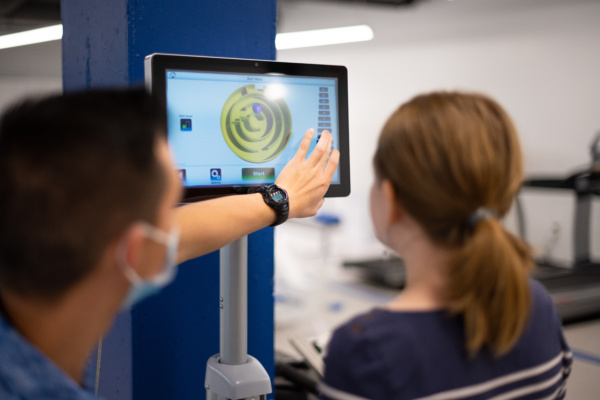Zachary Smith, freshman and student worker from Lilburn, Georgia, scans footage that was filmed when his parents were students in the 1990s. He hopes to find a shot or two that includes one of them. (Derek Eckenroth photo)
At Bob Jones University, treasure hides in a most unlikely place. Rather than being a chest full of gold coins buried by a long-ago pirate (Greenville is a little too far inland for that), the treasure consists of mostly unseen footage of the BJU campus from the 1940s to the early 2000s.
Located on the third floor of the Cinematic Arts Building, formerly known as Unusual Films, the footage resides in a specially designed film vault and contains many highlights of years past, from classes to commencements. Drs. Bob Jones Sr. and Jr.? Of course. Dr. Bob III as a teenager? Check. Dr. Panosian riding his bike through the rows in the Amphitorium? It’s there. Dr. Gustafson lip-syncing “My Old Flame”? That’s there too, along with decades of footage of students, faculty/staff and campus life.
Scanning the Film
Founded in 1950, Unusual Films was one of the first professional 16mm motion picture studios in the United States. When it closed on Oct. 28, 2016, it left a legacy of 70-plus years of 16mm motion picture film. With BJU’s 100th anniversary approaching in 2027, the film vault contents are a wonderful resource for the University.
But there are a few problems. First, while film can be more stable than video or digital formats, it is still subject to deterioration from shrinkage, physical damage and a condition known as “vinegar syndrome.” Some of BJU’s film resources are 70-plus years old; some are exhibiting these issues.
Also, for the footage to be usable with today’s technology, it needs to be transferred from film to a digital format. The University had great success when it outsourced the recent digital update of Sheffey, and the process gave that film new life and made it look better. But professional scanning is costly, and when first considered, a film scanner to do the work in-house seemed to be too expensive as well.
Preserving Content

When Unusual Films closed, David Eoute (’77 cinema grad) oversaw the disposition of the UF materials and equipment that the cinematic arts department didn’t want. The funds raised from the sale of these assets turned out to be the Lord’s provision for a way to purchase a scanner when a less-expensive professional 5K scanner for 16mm came on the market. It arrived in late August, and after extensive testing by Steve Ross and Bill Kimzey of the Marketing staff, scanning of 16mm film negative began in earnest.
To keep the scanner running as much as possible, several students and staff members have been trained to do the scanning. Later, long-time BJU staff members Dan Sandy, Laura Stevenson and others will add as much descriptive (names and places) metadata as they can in order to make the database more searchable. Willing alumni and BJU retirees may be pressed into service in the future to help identify the picture content.
Of course, all of this takes a lot of digital storage, especially for film that is digitized at high resolution. A 280-terabyte NAS storage unit was purchased to start; more storage may be required as the project progresses, especially to maintain the industry standard of having two additional digital backup files. And, of course, once the footage is digital, it will have to be migrated forward periodically as digital formats change.
Only a Start
But the raw footage is just the tip of the iceberg. Eventually, the goal is to scan all the films that Unusual Films released in order to make new high-quality transfers of them available, along with cinema student senior projects and other film assets. Video and audio formats, as well as many thousands of slides, also need to be transferred. The project is estimated to take at least five years to complete – just in time for the University’s 100th anniversary.








